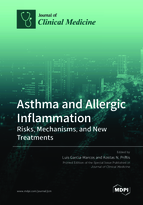Asthma and Allergic Inflammation: Risks, Mechanisms, and New Treatments
A special issue of Journal of Clinical Medicine (ISSN 2077-0383). This special issue belongs to the section "Immunology".
Deadline for manuscript submissions: closed (30 December 2020) | Viewed by 38305
Special Issue Editors
Interests: asthma; epidemiology; lung function; children
Special Issues, Collections and Topics in MDPI journals
Interests: asthma; allergic diseases; asthma management; lung diseases; spirometry; airway obstruction; pulmonary medicine
Special Issues, Collections and Topics in MDPI journals
Special Issue Information
Dear Colleagues,
We are all aware that asthma is a public health issue worldwide as the condition is highly prevalent, frequently undiagnosed, often under- or ill-treated, and kills many people (more than malaria, in fact). Although there are good treatments and a plethora of guidelines and strategies, no dramatic advance has been performed in the past two decades. The affordability of even cheap treatment combinations in low- and middle-income countries is an important limitation for asthma control in those countries. However, even in high-income countries with access to the new monoclonal antibodies, the burden of the disease in terms of DALYs is enormous, especially in children. Furthermore, the costs for patients and/or health systems, both direct and indirect, is not negligible. As a way to overcome the paralysis in the era of personalized medicine, there is a need for a change of paradigm, in which the term ‘asthma’ is not the start and the end of the diagnostic pathway but succeeded by the question of ‘what sort of asthma is this patient suffering of’ in terms of airflow obstruction, airway inflammation, and infection. Under the light of those terms, the present Special Issue aims to put together all that we expect the asthmatic condition to be now and in the decades to come.
Prof. Luis Garcia-Marcos
Prof. Kostas N. Priftis
Guest Editors
Manuscript Submission Information
Manuscripts should be submitted online at www.mdpi.com by registering and logging in to this website. Once you are registered, click here to go to the submission form. Manuscripts can be submitted until the deadline. All submissions that pass pre-check are peer-reviewed. Accepted papers will be published continuously in the journal (as soon as accepted) and will be listed together on the special issue website. Research articles, review articles as well as short communications are invited. For planned papers, a title and short abstract (about 100 words) can be sent to the Editorial Office for announcement on this website.
Submitted manuscripts should not have been published previously, nor be under consideration for publication elsewhere (except conference proceedings papers). All manuscripts are thoroughly refereed through a single-blind peer-review process. A guide for authors and other relevant information for submission of manuscripts is available on the Instructions for Authors page. Journal of Clinical Medicine is an international peer-reviewed open access semimonthly journal published by MDPI.
Please visit the Instructions for Authors page before submitting a manuscript. The Article Processing Charge (APC) for publication in this open access journal is 2600 CHF (Swiss Francs). Submitted papers should be well formatted and use good English. Authors may use MDPI's English editing service prior to publication or during author revisions.
Keywords
- Asthma
- Definition
- Epidemiology
- Diagnosis
- Treatment
- Exacerbation
- Phenotypes
- Therapy adherence








